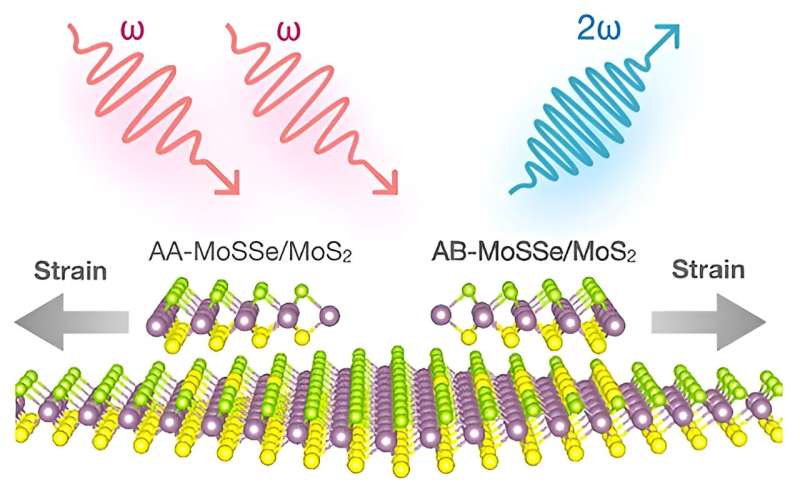This article has been reviewed according to Science X's editorial process and policies. Editors have highlighted the following attributes while ensuring the content's credibility:
fact-checked
peer-reviewed publication
trusted source
proofread
Stacking order and strain boosts second-harmonic generation with 2D Janus hetero-bilayers

A group of researchers from Tohoku University, Massachusetts Institute of Technology (MIT), Rice University, Hanoi University of Science and Technology, Zhejiang University, and Oak Ridge National Laboratory have proposed a new mechanism to enhance short-wavelength light (100–300 nm) by second harmonic generation (SHG) in a two-dimensional (2D), thin material composed entirely of commonplace elements.
Since UV light with SHG plays an important role in semiconductor lithography equipment and medical applications that do not use fluorescent materials, this discovery has important implications for existing industries and all optical applications.
Details of the research were published in the journal ACS Nano on August 29, 2023. The study was selected to be featured on the cover.
Janus Transition Metal Dichalcogenides (TMDs) are a specific class of 2D materials, typically composed of a transition metal (such as molybdenum or tungsten) sandwiched between two chalcogen elements (such as sulfur, selenium, or tellurium). Named after the Roman god Janus, who had two faces looking in opposite directions, Janus TMDs do not have inversion symmetry between two surfaces of thin material. This built-in asymmetry makes Janus-TMD materials suitable for SHG, particularly when the two TMDs are hetero-stacked.
SHG is a nonlinear optical process in which two photons with the same frequency (ω) interact nonlinearly with the material, and as a result, a single photon with twice the frequency (2ω) (or half wavelength) is generated. Basically, it is a phenomenon where incoming light is converted into light with double the frequency or half wavelength.
SHG is important in various applications, including laser technology, microscopy, medical science and solid state physics. SHG is used to generate light with shorter wavelengths, which can be valuable in fields like semiconductor lithography equipment and medical applications, such as imaging techniques that do not use fluorescent materials.
"Our team of researchers optimized conditions of SHG in heterobilayers of the 2D Janus TMD materials," points out Nguyen Tuan Hung, assistant professor at the Frontier Institute for Interdisciplinary Science (FRIS), Tohoku University. "Specifically, we found that AA stacking, in which atoms in the top layer directly overlap atoms in the bottom layer, and AB stacking, in which atoms in the top layer do not directly overlap atoms in the bottom layer, resulted in a threefold enhancement of the former in the nonlinear optical response of the SHG." This theoretical prediction agreed with the fact that the SHG peak intensity is four times larger for AA stacking than for AB stacking in the experiment.
"Thus, we have suggested that SHG intensity is also a useful way to determine how the layers of 2D materials are stacked," said Nguyen. In addition, the researchers suggest that adding lateral strain (up to 20%) to these materials can further increase the light intensity significantly."
"Our research introduces a new category of materials that produce SHG, and we can make them in a flexible way using 2D materials," adds Nguyen.
More information: Nguyen Tuan Hung et al, Nonlinear Optical Responses of Janus MoSSe/MoS2 Heterobilayers Optimized by Stacking Order and Strain, ACS Nano (2023). DOI: 10.1021/acsnano.3c04436
Journal information: ACS Nano
Provided by Tohoku University





















